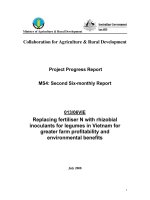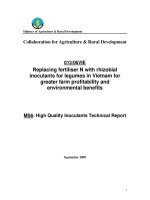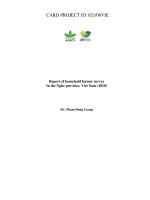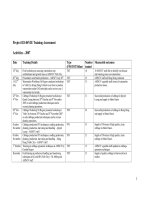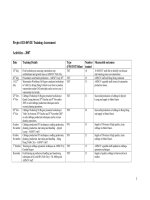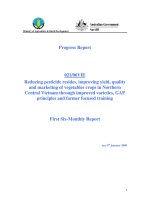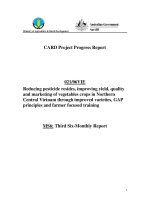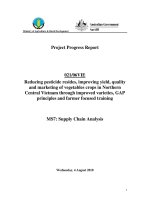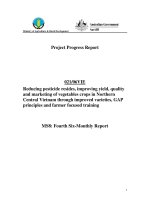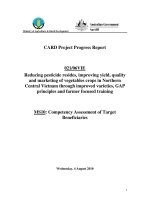Báo cáo khoa học nông nghiệp " CLOSER LINKS BETWEEN RESEARCH, PRODUCTION AND MARKET TO ASSURANCE OF SAFETY AND HIGH QUALITY VEGETABLES FOR CONSUMERS " potx
Bạn đang xem bản rút gọn của tài liệu. Xem và tải ngay bản đầy đủ của tài liệu tại đây (151.96 KB, 17 trang )
GAP Workshop in Binh Thuan (21-22/7/2008)
1
CLOSER LINKS BETWEEN RESEARCH, PRODUCTION AND MARKET TO
ASSURANCE OF SAFETY AND HIGH QUALITY VEGETABLES
FOR CONSUMERS
Research Project Title:
Reducing pesticide residues, improving yield, quality and marketing of vegetables crops in
Northern Central Vietnam through improved varieties, GAP principles and farmer focused
training (021/06VIE).
Name of Reporter/ Authors: Pham Van Chuong, Gordon Rogers, Pham Hung Cuong et al.
Implementing agency: Agricultural Science Institute of Northern Central Vietnam,
Vietnamese Academy of Agricultural Science
I. INTRODUCTION AND RESEARCH OBJECTIVES
The total area in Vietnam used for vegetable production is currently 643,970 ha of (Statistical
Head Department, 2006) and is a 5% increase over the area of land used for vegetable
production in 2001. Of this total vegetable production area, only 22,000 ha or 5% are grown
using safe vegetable production practices. Full GAP accredited vegetable production is still
insignificant area, only account for 2% of the total area (ASEAN-GAP training workshop,
April 2008. MARD).
Vegetable growing in Vietnam is an important source of income for the country and accounts
for 9% of the total cropping income including rice. The major vegetables produced in
Vietnam are KangKong, brassica’s (cabbage, pak choi & kohlrabi) and various cucurbits
including melons and cucumbers (Anh, Ali et al. 2004).
There is potential to increase these returns to growers by maximizing yield and quality of the
produce they grow. However, there are several aspects of the vegetable industry in Vietnam
currently limit expansion and development of the industry and financial returns to farmers.
These limitations include:
• High pesticide and nitrosamine residues in produce
• Poor post harvest temperature management and handling technology which reduces
the quality of produce which reaches consumers
• Agronomic practices used by growers can limit potential yields and hence farmer
income
• Traditional marketing practices can limit farmer returns
Pesticide Residues
A recent study has shown that up to 22% of the vegetables consumed in Vietnam may be
unsafe to eat because of pesticide residues, heavy metal contamination and high nitrosamine
levels (Health and Life, No. 204, Nov. 2002). In Hanoi, 9% of vegetable samples exceed
pesticide residue limits and 7% have residues of banned pesticides (Moustier, Bridger et al.
GAP Workshop in Binh Thuan (21-22/7/2008)
2
2002; Anh, Ali et al. 2004). There are over 30% vegetable samples in Nghe An province in
the 2007 year which have residues pesticides with 15% over permitted levels (P.H. Cuong.
2008).
In addition to pesticide residues, nitrate levels in vegetable products are commonly several
times higher than permitted levels (Thach 1999), and are caused by the use of excessive
nitrogenous fertilizer (Thi 1999; Thi 2000; Ha and Ali 2005).
Despite the heavy pesticide use, significant proportions of crop yields are lost to pests and
diseases e.g. 25% of leafy vegetables, 23% of cucurbits and 32% of brassicas (Anh, Ali et al.
2004). One factor which further complicates the pesticide residue issue, is that constant high
humidity (>75%) in many growing areas encourages foliage diseases and fungicide spraying
to control these diseases (Anh, Ali et al. 2004).
The widespread use of broad-spectrum insecticides also kills beneficial predatory insects and
this further encourages the use of pesticides to control insects which were previously
controlled by the beneficial. Better practices involving IPM principles and the use of disease
resistant varieties in a GAP framework will reduce the problems associated with
indiscriminate pesticide and hopefully increase consumer confidence in vegetable produced in
Vietnam.
The project team aims to use a collaborative approach involving participatory learning that
will involve new vegetable varieties with reliable disease resistance combined with
monitoring of pest and disease levels that will reduce the need to spray pesticides. Good
Agricultural Practice (GAP) principles and a manual will be then be used in training
programmes to assist with the adoption of these improved methods of pest and disease control
(Ledger, Premier et al. 2006). The result will be improved production systems and quality for
buyers and consumers.
Post Harvest Handling
There can be a significant loss of quality of vegetable products in the supply chain, especially
in retail. There are significant opportunities to improve the quality of produce reaching
consumers and for reducing losses in the supply chain by improving product handling and
temperature management. For example, vegetables are mainly handled in cane baskets and
not cartons or any form of purpose built container designed to support the weight of stacked
produce. There is little use of well-established postharvest technologies such as forced-air
cooling, refrigerated transport, cool rooms on farms or at market facilities. There is little
attempt to control ethylene emissions around harvested products, which are well known to
reduce the quality and storage life of fruits and vegetables.
The current handling and marketing system works well if fruit and vegetables are consumed
within about 24h of harvest, but it severely limits any development of export markets and
retail marketing through stores or supermarkets where a longer shelf life is required and
consumers expect to purchase high quality products. The postharvest technology required to
improve produce is available. The key requirements for improvements in this area are:
• Incentives for farmers and marketers to improve post harvest handling
• Some new infrastructure, e.g. access to cool rooms and better containers for produce
• Training on current post harvest handling techniques
GAP Workshop in Binh Thuan (21-22/7/2008)
3
Good Agricultural Practice (GAP)
GAP projects in South East Asia have generally resulted in major improvements in yield,
quality of produce reaching the consumer and in food safety. Food safety improvements have
been achieved through a reduction in microbial contamination of food as well as through
measurement of pesticide residues in fruit and vegetable crops (Kawakami, Khai et al. 1999;
Dobermann, Witt et al. 2002). (Ledger, Premier et al. 2006) have just produced a GAP
manual for fresh produce in the ASEAN region which will be a useful template for the
development of a GAP manual for Brassica’s and Cucurbit crops in Vietnam.
The project takes expertise in plant protection, crop nutrition and irrigation management
developed in Vietnam e.g. at RIFAV and local MARD agents and then build on the findings
Australian agronomic projects on the same crop groups.
Marketing
Marketing is emerging as a key driver of profitability for small holder vegetable farmers in
Vietnam. Low market prices was identified as a serious socio-economic constraint to
vegetable production by 61.5% of rural producers in the peri-urban region around Hanoi
(Anh, Ali et al. 2004). At the same time, there is a trend away from the traditional marketing
system of crops being purchased by collectors and sold in traditional wet markets to high
quality produce being sold through supermarkets (Quang & Argenti, 1999). A range of
supermarkets now sell produce including Metro Cash and Carry, Citimart, CoopMart,
Fiuimart, Hanoi Minimart, Western Canned Food and Star Bowl. The future will be for these
supermarkets to introduce quality standards and then buy high quality, clean produce direct
from farmers who meet the Quality Assurance (QA requirements).
This project will assist growers in adapting to this system through the involvement of a major
emerging supermarket chain in Vietnam, Metro Cash and Carry. The development of this
linkage will be facilitated by Mr John Baker from Produce Marketing Australia (PMA).
Key project’s objectives:
- Contribute to reduced pesticide residues in cucurbits and Brassica crops in the Central
Coast regions
- Provide an opportunity to increase farmer income through higher yields and better
quality of marketed vegetables
- Create increased market opportunities for small farmer householders by improving
vegetable quality and presentation.
II. MATERIALS AND METHODS
The project is focused on outdoor farmers adopting methods to produce clean high quality
vegetables by:
1. New varieties: Introducing and evaluating new varieties with good pest and disease
resistance, and agronomic characteristics in field trials at Quynh Luong Commune, Quynh
Luu, Nghe An province and at ASINCV at Vinh city, Nghe An province. These trials will be
used to select the best performing new varieties introduced from seed companies know to the
Australian team. These trials will select good varieties from collections of seed companies in
Asia and Vietnam.
GAP Workshop in Binh Thuan (21-22/7/2008)
4
According to baseline survey result, there is diversity of varieties of Brassica and Cucurbits
genus has been planting at visited local. Therefore in order to adopt with project’s targets we
selected 2 crops are cabbage and watermelon. Some varieties with good resistant to pest and
diseases traits were selected from seed companies such as EastWest (Vietnam), Seminis Seeds
Ltd, Syngetnta, and AVRDC. Trials and demonstration including:
• Cabbage varieties: Green Helmet (Black rot tolerance); and 8 others new
varieties.
• Watermelon varieties: CS202, CN46, others new promising varieties.
2. Experimental designs are standard methods: Replicated field trials were set up at the
Agricultural Science Institute of Northern Central Vietnam to evaluate varieties, planting
densities, planting time (season) and nutrition.
Semi-commercial plantings of cabbage (winter) and watermelons (summer) were established
at Quynh Luong commune and Hung Dong collective. Trials shipments of produce grown
using GAP standards have been marketed through Metro Cash and Carry all over Vietnam.
Baseline data has been collected on current farmer practices and crop samples have been
collected and pesticide residue levels quantified to provide baseline data for the project.
3. Participatory Agronomic Training: There have been regular training sessions conducted
at both farm communities and for professional staff at ASINCV. The field trials provide
training on experimental design and management as well as providing resources for growers
for the field days. The production of the GAP manual provides information that is used in
Farmer Field Schools. The documents will provide training for research institutes but will also
provide relevant information for growers and retailers that will be included in the GAP
manual.
4. Post harvest Research and Training: Post harvest research into the temperature profile of
products through the supply chain will highlight areas for improvement in packaging and
package orientation within the truck to reduce temperature build up during transport. This
research is the first step in mapping the supply chain to determine areas for improvement.
Vietnamese researchers have already visited Australia and been trained in the Fresh Care
Quality Assurance system (NSW Dept Primary Industry) and a similar QA system will be
initiated for participating farmers in this project.
5. Developing supply chain links between Metro Cash and Carry, ASINCV, RIVAF and
province level MARD extension centre and district level extension station staff, growers and
retailers to ensure an effective supply chain. Mr John Baker is facilitating this part of the
project. Produce Marketing Australia’s main role will be to co-ordinate and help set up the
marketing linkages between Metro Cash and Carry, vegetable collectors and farmers. This
link will be crucial because the higher standards required by Metro and the associated higher
returns to growers will be the incentive for farmers to adopt the new techniques. These supply
chain linkages will be appropriately mapped.
GAP Workshop in Binh Thuan (21-22/7/2008)
5
III. RESULTS AND DISCUSSION
1. Research on variety selection for project sites
1.1. Cabbage production and trials
In company with the commercial plantings there were also trials planted at ASINCV (Vinh
City) these aim to develop an integrated cultural practices. These trials include:
Cabbage variety trials: New cabbage varieties with improved disease resistance and
agronomic type are being evaluated at ASINCV, Quynh Luong Commune and the Hung
Dong Co-operative. There are 9 varieties in the experiment in winter crop condition of 2007
year. Results are presented in Table 1. The variety SVR11750311 showed the highest yield at
40.1 t/ha, fast growing and good appearance. In the pilot studies, the variety Green Helmet
was shown to be adaptable to local climate condition and met Metro supermarket’s
specifications. It also had are good resistant to some pests and diseases, tolerance to black rot
disease especially and attractive medium size heads weighing 1.2 – 1.4 kg.
Table 1. Yield and head characteristics of cabbage trial at ASINCV 2007.
Leaf number
Average head weight
(kg)
Head size (cm) Yield (t/ ha)
Variety name
Outer Inner Total Trimmed Height Diameter Actual Yield
BC76
10.3 40.8 1.90 1.30 15.2 17.7 34.4
SG129
15.4 37.7 1.20 0.76 11.5 14.4 19.2
SG130
19.5 36.2 1.56 0.94 13.5 16.2 24.6
Kilaherb
(control)
16.4 41.0 1.87 1.00 13.0 13.7 26.8
Gloria
16.2 41.7 2.00 1.27 14.9 15.8 33.6
KKcross
(control)
13.8 31.3 1.91 1.30 11.6 18.6 37.7
SVR11750311
16.4 42.7 2.00 1.50 12.9 20.2 40.1
PS11190
16.0 41.5 1.75 1.20 12.5 14.5 32.4
Green Helmet
(Sakata)
16.4 41.0 1.57 1.00 13.9 16.7 26.8
LSD 0.05
2.84
Agronomic Trials at ASINCV: Planting time, density and nutrition trials have been set up
using plants from the second seeding of Green Helmet. The results shown that best suitable
planting time is from 30 Oct. to 10 Nov. 2007 with highest yield. Cabbage nutrition and
planting density trials have also been conducted at ASINCV and the results show that the best
planting in the Central coastal region, beds should be 1.2 m wide, on 2 rows per bed (50cm
apart) and 40 cm between seedlings produced the highest yield of 1.2 kg cabbage heads.
GAP Workshop in Binh Thuan (21-22/7/2008)
6
Optimum fertilizer rate was 150 kg/ha N, 100 kg/ha P
2
O
5
and 50kg/ha of K
2
O. IPM resulted
in adequate control of insects.
GAP production pilots: At the same time of trials at ASINCV, production demonstrations
were carried out on semi-commercial pilot plantings at Quynh Luong and Hung Dong. The
farmers developed a planting schedule with Metro Cash and Carry and agreed to plant 4 times
from 25 Sep. till to 18 Dec, 2007. The Green Helmet variety was selected for production
because it has good disease resistance meets Metro’s specifications and has a good
appearance. Between the two sites, 57,000 seedlings were planted which resulted in 50 tonne
of cabbage heads being delivered to Metro via the platform in Hanoi, and then to all other
stores in Vietnam. The plants and harvested heads were in excellent condition as the farmers
were using Integrated Pest Management (IPM) for pest and disease control.
Dr. Gordon Rogers visited Vinh City 22
nd
– 26
th
October to assist with the transplanting of the
seedlings into cooperative sites, participate in farmer field schools and to plan the agronomic
trials at ASINCV.
1.2. Research on watermelon crop
Variety selection trials: 13 new promising varieties of watermelon crop were trialed to
compare agronomic traits. The replicated experiments were set up on two sites, Quynh Luong
and Hung Dong (Vinh city). Farmers and scientists assessed varieties independently. Farmers
prefered high yield, good resistance to pests and diseases, but did not really consider the
supermarket specifications and customer preferences. Eg. some farmers selected VN27 and
VN38 with large fruit size and high yield. Few farmers selected CS202 and CN46, because
their yields were lower than VN27 and VN38, however CS202 and CN46 fruit were of good
quality with high Brix (10.5 – 11.6) and fruit characteristics which more closely matched the
customers’ preference (See Table 2). After discussion the farmers decided to use CS202 and
CN46 varieties for the planned expansion next season.
Table 2. Yield and constituents of watermelon yield in the trial at a planting density of
7400 plants per hectare
No Trait name
Variety
/ Site name
Average fruit weight
(kg)
Yield (t/ha)
I. Hung Dong
1 CN-46 2.6 21.5
2 SWEET 16 4.2 35.6
3 WD2503 3.7 9.2
4 SWEETS
ENORITA
2.9 31.3
5 CS - 202 2.4 27.1
LSD (0.05) 2.77
II. Quynh Luong
6 VN26 3.47 66.0
7 VN30 3.12 67.3
8 VN27 4.09 90.1
9 VN40 3.22 74.0
10 VN31 2.85 58.5
GAP Workshop in Binh Thuan (21-22/7/2008)
7
11 VN35 4.34 73.9
12 VN38 4.77 95.5
13 VN9 4.68 82.1
LSD (0.05) 4.42
Agronomy trials: Planting time, planting density and nutrition trials have been set up at
ASINCV experimental field using SC202 and CN46 varieties. The data is currently being
analyzed.
GAP production pilots: Two semi-commercial pilot watermelon trials set up in 2007 at
Quynh Luong and Hung Dong. Two watermelon varieties were planted which were suited to
the climate in the central coastal region of Vietnam, and which met specifications from Metro
supermarket of - 2.5 kg weight, good internal color and soluble solids level (Brix). The
varieties chosen were CS202 and CN46 varieties. Trials following replicated trials were also
conducted in watermelons. Total shipments to Hanoi was estimated up to 100 tons, delivery
timeframe is from early June to Aug. with 7-10 ton per week, therefore first planting is 20
March, and last planting is 10 June of 2008.
2. Development of Good Agricultural Practice manual.
The project will use a participatory approach to encourage the uptake of good agricultural
practices (GAP) by the collaborating Vietnamese Institutes and the stakeholders (farmers,
extension staff and commercial partners).
The manual will be developed collaboratively
between Vietnamese and Australian teams for two major annual crop groups: cucurbits and
brassicas and will be a practical guide and will include information on varietal selection and
evaluation; water management; crop nutrition; crop scheduling; effective pest and disease
management including insect scouting; and, correct postharvest handling (i.e. harvest
maturity, temperature management, grading, transport and packaging).
Training courses were held on farm based around trials and production pilot trials. Training
courses include FFS and TOT. Documents and materials were developed based on practices
activities that will be used for GAP manual development.
The project team was developed record forms for Quality Assurance and farmers encouraged
keeping their own records. The farmers have also begun to keep detailed records of their
agronomic practices for traceability, which is an important first step for introducing a QA
system in the future. (See also Appendix 2)
3. Uniting smallholder farmers into a group for safe vegetables production
First step of the project was a baseline survey to understand socioeconomic conditions at 3
sites with 90 farmer householders in Nghe An province. The survey was also used for site
selection based on major criteria to choose 2 sites for implementing next activities. The first
baseline survey was carried out at:
• Hung Dong commune, Vinh city
• Quynh Luong commune, Quynh Luu district
• Hung Loi commune, Hung Nguyen district
Site selection criteria included:
GAP Workshop in Binh Thuan (21-22/7/2008)
8
• Soil and climate conditions
• Traditional vegetables cultivation practiced
• Diversity of brassica and cucurbit crops produced and a need to improve the quality of
vegetables and marketing.
Therefore there are 2 sites were selected for project implementation are:
1. Quynh Luong commune located near the coast, 80 km from north to Vinh city where
140 ha of vegetables are grown by 1000 farmer householders with plentiful fresh
water from wells. Good soil and climate conditions for vegetables. Local farmers are
planting vegetables such as onion, leafy cabbage, tomato, carrot, cucurbits.
2. Hung Dong commune located closed with Vinh city, with 30 ha of vegetables
production including young seedling vegetables, leafy cabbage, cucurbits. Local
authorities are intending to expand more vegetables areas production up to 100 ha in
future.
Farmers at both 2 sites have previously grown cabbage and watermelon, but had changed to
plant others short duration vegetables and high return. Produce has been sold to local markets
or collectors with low return and unknown quality.
Next, commune executive committee and preference farmer group were established. They
held meeting to discuss activities that were needed achieve successful production of clean,
high quality target vegetables crops.
Professional input will be provided by ASINCV and MARD staff to provide some guidance
on scientific aspects of compliance with safety specifications and QA. Farmer groups have
been trained in the practices on their farms based required to hopefully achieve FreshCare and
VietGAP accreditation.
4. Linking with supermarkets for product outputs
The link between Metro Cash and Carry supermarket was developed with support from
Australian marketing experts and Vietnamese scientists, Metro buyer and farmers. The Metro
fresh produce buyer from Hanoi (Mr Thai) has visited project sites at Quynh Luong commune
and Vinh city and was very impressed by the operations. These meetings were very valuable
in opening communication between Metro and the farmers. This project is to date, the only
example of direct farmer-Metro communication in Vietnam
Farmer representatives have also visited Metro’s Hanoi operations to better understand how
the cabbage and watermelon needs to be prepared for market. The farmer group and Metro
buyer negotiated a supply contract, according to Metro specifications. The team also
developed and agreed planting schedule.
The marketing strategy developed for the cabbages involved the promotion in the Metro Cash
and Carry magazine as well as in in-store posters and promotions. In addition, each cabbage
had a sticker attached which indicated it was produced under the guidelines of safe vegetable
production. There was also information provided to Metro staff on how to handle the product
in the store, and how the crops were produced (see Appendix 1). On completion of the first
season of cabbage we will prepare articles for local newspapers to promote the potential
success of this type of supply chain and production system.
GAP Workshop in Binh Thuan (21-22/7/2008)
9
The successful marketing strategy and production strategy has resulted in 50 tonnes of
cabbage being delivered to Metro supermarket, from January 2008 to early April 2008. This
summer, 100 tons of watermelons are planned to be delivered to Metro from early June to
Aug 2008.
5. Farmers training.
Farmer field schools were run at both Quynh Luong Commune and Hung Dong Co-operative.
These were based around growing the commercial pilot trials to supply Metro supermarket.
The cabbage and watermelon variety trials were also used as a demonstration trial at each site.
Two Integrated Pest Management (IPM) and postharvest workshops were held on the
December 5
th
and 6
th
, 2007. Thirty one people attended the Quynh Luong workshop, and 23
people attended Vinh City workshop.
Farmers used Integrated Pest Management (IPM) and GAP principles, and as a result the
crops were in excellent condition. The farmers kept written records in booklets specially
prepared. This was seen as the first step to developing and on farm QA system.
Vietnamese (5) and Australian (1) collaborators attended GAP training workshop in Hanoi 3 -
5
th
December, 2007 for tomato and cucumber production. Many principles discussed at this
meeting were also relevant to cabbage and watermelon and will be included in the GAP
manuals produced for this project. Training course on ASEAN-GAP in 8
th
May, 2008,
holding by MARD at ASINCV.
IV. CONCLUSION
The on-farm trials at the Quynh Luong commune and Hung Dong co-operative have he;ped
facilitate the uptake of new farming practices. This will continue with subsequent seasons and
more growers are expected to participate in the commercial plantings if the initial trials prove
to be profitable.
The highlight from this reporting period is the production of high quality cabbages using GAP
at Quynh Luong commune and Hung Dong (Vinh city) and the enthusiasm from Metro Cash
and Carry to sell these products in the Hanoi store. This is a very positive step for developing
an alternative supply chain for these farmers which could be more reliable and profitable than
the existing ones they use. The use of IPM and the agronomic record books has also been an
important first steps for the adoption of a QA system for the growers.
At present, the Vietnamese vegetable industry often fails to meet the requirements of many
QA systems such as ASEAN GAP or EURO GAP. The practices introduced for the cabbages
and watermelon in Nghe An province are the first step for farmers in learning what is required
to meet ASEAN GAP or VietGAP standards. These QA systems will only be adopted if there
is a financial benefit for the increased effort. It is hoped that the linkage with Metro Cash and
Carry will provide the financial incentive for the farmers to produce clean vegetables to meet
ASEAN or VietGAP standards.
The initial successful achievements of project this CARD project (021/06VIE) should be
publicized widely to vegetable producers, not only cucurbits and brassicas but also other
vegetables crops in central coastal part Vietnam.
GAP Workshop in Binh Thuan (21-22/7/2008)
10
REFERENCES
1. Anh, M. T., M. Ali, et al. (2004). Urban and Peri-urban Agriculture in Hanoi:
Opportunities and constraints for safe and sustainable food production.
Technical Bulletin No 32
, AVRDC: World Vegetable Centre and CIRAD.
3. Ha, T. and M. Ali (2005). Analysis of the peri-urban system in Hanoi
. SUSPER
Project, AVRDC/CIRAD, Shanhua, Taiwan
4. Kawakami, T., T. T. Khai, et al. (1999). "Development and practice of the
participatory programme on improving working and living conditions in rural
communities in the Mekong delta area in Vietnam." Journal of Science of
Labour 75(2): 51-63.
5. Ledger, S., R. Premier, et al. (2006). "Harmonising GAP prgrams for fresh
produce in ASEAN region." ACTA Horticulturae
712: 523-525.
6. Moustier, P. E., N. T. Bridger, et al. (2002). Food saftey in Hanoi's vegetable
supply: insights from a consumer survey. Food Safety Management in
Developing Countries, Montpellier France, CIRAD-FAO.
7. Thach, N. X. (1999). Effect of land environment, water and fertilizers to safe
vegetable production and adaptation of agricultural land inplanned vegetable
production areas in Hanoi province. Department of Agronomy
. Hanoi, Hanoi
University. PhD.
8. Thi, T. K. (1999). Study on the environmental factors and solutions on safe
vegetable development. National Workshop on Safe and Year-round Vegetable
Production in Peri Urban Areas, Hanoi, CIRAC/RIFAV.
9. Thi, T. K. (2000) "Safe vegetable development to supply Hanoi (Vietnam)."
Background paper for FAO seminar, Feeding Asian Cities
Volume, DOI.
10. Cuong P.H. (2008). The real situation of Good Agricultural Practice use for
vegetables production in the North central part of Vietnam. Paper for the
training workshop in re-disseminating ASEAN-GAP for vegetables. April,
2008. MARD.
GAP Workshop in Binh Thuan (21-22/7/2008)
11
APPENDIX
Appendix 1:
An Integrated Production, Distribution and Marketing Plan
for Melon and Cabbage in Vinh Province, Vietnam
Background:
A collaborative project between researchers and farmers in Vinh Province of Vietnam and
Applied Horticultural Research in Australia aims to improve the income of smallholders by
encouraging adoption of clean and sustainable production practices.
Components of the project include:
• Reducing pesticide residues and
• Improving yield, quality and marketing of Cucurbit and Brassica vegetable crops in
Northern Central Vietnam through:
Improved varieties,
GAP principles and
Farmer focused training.
Major activities include:
1. New melon and cabbage products being marketed to consumers, initially through
Metro Cash & Carry Vietnam.
2. New technology developed, tested and documented on how to produce melons and
cabbage in Vinh Province.
3. Improved links between the industry, research and extension organisations involved in
the project.
4. Two scientists from Vietnam trained in Australia in the production of melons and
cabbage.
To maximize the benefits of the program to farmers in Vinh Province, an integrated
production, distribution and marketing plan is proposed, based on the melon and cabbage
product specifications nominated by retailer Metro Cash & Carry Vietnam.
Some Components of the Plan:
INTEGRATED PRODUCTION AND MARKETING PLAN
PRODUCTION DISTRIBUTION SALES & MARKETING
Product Specifications Packaging Sales Coordination
Production Systems Transport Branding
Harvest/Post Harvest Promotion
Quality/Food Safety Training Communication Participation
GAP Workshop in Binh Thuan (21-22/7/2008)
12
PRODUCTION:
1. Product Specifications – supplied by Metro Cash & Carry Vietnam
2. Production systems, incorporated in a Good Agricultural Practice (GAP) Manual and
including:
a. New Varieties
b. Crop scheduling
c. Water management
d. Crop nutrition
e. Pest and disease management
3. Harvest/ Post Harvest practices, incorporated in GAP Manual
a. Harvest maturity
b. Harvest scheduling
c. Temperature management
d. Grading and packing
DISTRIBUTION:
1. Packaging
a. Carton selection best suited to each product
b. Efficient packing in cartons
c. Stacking for transport
2. Transport
a. Maintaining ‘cool chain’
b. Minimizing damage – rice straw etc
c. Reliable delivery
3. Supply Chain Links
a. ASINCV, RIVAF and province level MARD extension centre and district level
extension station staff
b. Growers and
c. Retailer
SALES & MARKETING:
1. Sales Coordination
a. Establish sales and marketing structure - cooperative
b. Select and appoint sales coordinator
2. Branding
a. Cartons
b. Individual products e.g.
i. Labels on melons
ii. Ties on cabbage
c. Retail materials – posters, leaflets
3. Promotion
a. In-store (Metro)
i. Posters, leaflets etc (branded)
ii. In-store sampling
GAP Workshop in Binh Thuan (21-22/7/2008)
13
iii. Metro staff education
b. Food service customers – tourist hotels and restaurants
c. Trade e.g. ‘Asiafruit’ magazine
QUALITY/FOOD SAFETY:
Document in GAP Manual and communicate to farmers/suppliers (including training)
1. Quality standards required, based on Metro specifications
2. Food safety requirements, based on international standards
TRAINING:
ASINCV and RIFAV:
• Field trials - training on experimental design and management
• ELISA system to test for pesticide residues
• Mapping supply chain to determine areas for improvement
• Marketing
• Fresh Care Quality Assurance system
Farmers:
• Farmer Field Schools
• Field trials
• Preparation of GAP manuals
• IPM
• Post harvest
• Marketing
• QA system
COMMUNICATION:
Establish communication networks between farmers, researchers, AHR, Metro and their
customers.
PARTICIPATION:
1. Identify farmers interested in participation
2. Establish structure to coordinate supply in Vinh and sales and marketing program.
Produce Marketing Australia
August 2007
GAP Workshop in Binh Thuan (21-22/7/2008)
14
Appendix 2:
Farmers’ Record Sheets of QA measurement
for Melon and Cabbage in Nghe An Province, Vietnam
FIELD RECORD SHEETS
1. Diary record sheet of fertilizer/ Growth stimulating / soil preparation chemicals
Farmer name:
Sign no. (Accession No.):
Field / farm location:
Technical person:
Date Chemical detail Quantity (Kg/
litre)
Salesperson Rate (đồng)
(1) (2) (3) (4) (5)
2. Diary record sheet of pesticides
Farmer name:
Sign no. (Accession No.):
Field / farm location:
Technical person:
Date Chemical type Code Quantity Rate (đồng) Salesperson /
producer
(1) (2) (3) (4) (5) (6)
3. Diary record sheet of soil preparation
Farmer name:
Sign no. (Accession No.):
Field / farm location:
Technical person:
Date Environment to
be treated
Treatment Chemical
name
Dosage Area
(1) (2) (3) (4) (5) (6)
GAP Workshop in Binh Thuan (21-22/7/2008)
15
4. Record sheet of fertilizer use / growth promoting
Farmer name:
Sign no. (Accession No.):
Field / farm location:
Technical person:
Date Crop name Plot/ bed Fertilizer Treatment Dosage Area Applied
method
(1) (2) (3) (4) (5) (6) (7) (8)
5. Diary record sheet of plant protection chemical
Farmer name:
Sign no. (Accession No.):
Field / farm location:
Technical person:
Date Chemical
name
Dosage Spray
volume
Endemic
name
Crop
name
Area Sprayer
(1) (2) (3) (4) (5) (6) (7) (8)
6. Diary record sheet of epidemic control
Farmer name:
Sign no. (Accession No.):
Field / farm location:
Technical person:
Date Crop name Epidemic
name
Polluting level
(%)
Control plan Expertise
(1) (2) (3) (4) (5) (6)
GAP Workshop in Binh Thuan (21-22/7/2008)
16
7. Diary record sheet of product
Farmer name:
Sign no. (Accession No.):
Field / farm location:
Technical person:
Date Crop name Plot location Area Quantity
(1) (2) (3) (4) (5)
8. Diary record sheet of product classifying
Farmer name:
Sign no. (Accession No.):
Field / farm location:
Technical person:
Date Crop
name
Classification
(3)
Buyer Total sale
quantity
(đồng)
(1) (2) Level A
(kg)
Level B
(kg)
Level C
(kg)
Level
khác (kg)
(4) (5)
9. Postharvest treatment folder
Farmer name:
Sign no. (Accession No.):
Field / farm location:
Technical person:
Date Crop name Treatment
(1) (2) (3)
GAP Workshop in Binh Thuan (21-22/7/2008)
17
10. Record sheet of vegetables bring to market
Farmer name:
Sign no. (Accession No.):
Field / farm location:
Technical person:
Date Detail
Crop name
Variety
Sowing,
transplanting
Irrigation
Polluting matter
Pesticide names
1
2
3
4
5
6
7
8
9
10
Basal fertilizing
Top dressing
Leaf fertilizer
Additive
Harvest
Package
Transport to buyer
